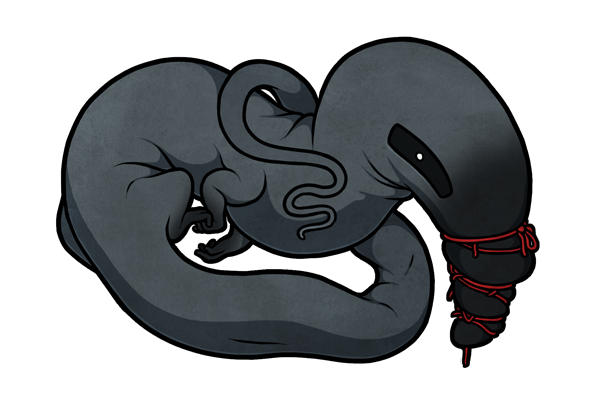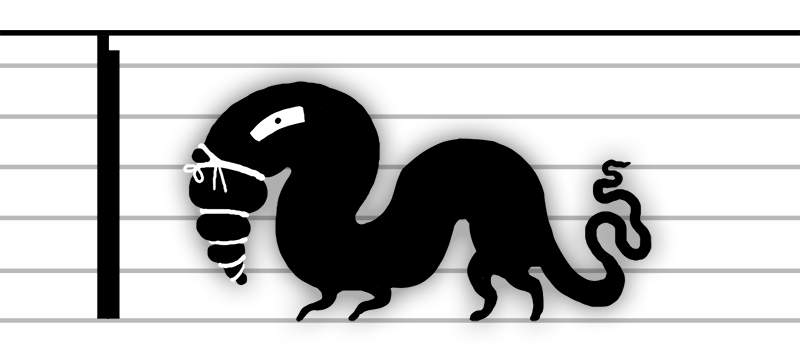

heuritristi
the weaving archaics
prefix heuri suffix tristi
xixo immiriorex
physical appearance
The heuritristi /hjuɹəˈtɹɪsti/ is a dark grey stranger with an ebon snout, stocky body, and an exceptionally long and tapered tail. Its skin is loose but leathery, and when touched, either sweats in small beads, or grows damp. Its rough, but thin skin covers an inner flesh interspersed with light-colored, sinuous thread. Appearing overly vulnerable to heat, the heuritristi's surface grows dark and flakes away when exposed to temperatures of over 112°F. When cut, the strain bleeds a clear-to-black fluid, and while this bleeding does cease after less than a minute or two, regeneration does not take place.
The heuritristi expresses itself without language.
the dragging sound of its hands across dry tile.

environment and generation
The heuritristi can be found within gloomy and ashy locales. Burnt-out rooms abandoned following house fires are one of its common environments, though the strain displays a general preference towards any somber colors, heat-damaged furniture, piles of black soot, and a lack of illumination. It almost never appears in exterior spaces, and when it does appear outside, is found only beneath shelter (such as under the protection of large awnings, roofs, and lean-to's).
Within the shadiest point in a room, the heuritristi starts off as a pile of fuliginous and soggy splinters, which merge together (not always successfully) until they coalesce into the heuritristi's overall shape. Once the stranger's form reaches a satisfactory point, the mass as a whole becomes flesh.
At first, the heuritristi displays some difficulty righting itself, with many false starts and forlorn shaking, until at last it either stands up or dies, breaking apart into wet fragments once more.
The strain generates only exceptionally infrequently, with years lapsing between occurrences.
behaviour
The heuritristi behaves as though both shell-shocked by an unseen past, and terrified of future events. It reacts to all sudden stimulus with a frigidity of motion, shaking in the aftermath of the booming sounds or flashing lights, and becoming reassured of any safety only once its environment returns to a stable state.
Immediately following its generation, the heuritristi roams in search of string. In its search, it rifles through piles of debris, runs its hands between the gaps in floorboards, or pulls down wallpaper or plaster. Though persistent in its search, its motions do not grow hurried.
Each heuritristi displays a three-day period in which it must find a suitable string, which it wraps around its nose (tightly enough to cut into the flesh at times) and ties in a series of adept knots. A heuritristi's tastes and criterion cannot be predicted; one string may be rejected without being tied, while another may be picked up, tied on, and pulled off after less than a minute. Metal wires do not tend to be selected (but are not spurned altogether), and electrical cords are never chosen.
After three days, a heuritristi without a string becomes locked in a motion in which it raises its arms and hands and appears to tie an unseen cord around itself. After doing this 1-13 times, it grows stiff and dies. A variable percentage of heuritristi (between 1 and 13% of individuals within a city) tie strings around their forearms or tail, rather than around the head; after three days, these individuals also grow stiff and die, albeit without the "phantom tying" of the aforementioned group.
Although a string-bearing heuritristi grows no more confident in its demeanor, it does develop a newfound propensity towards boredom. With no more need to roam, it punctuates its periods of rest or shelter by rubbing at the walls, pushing its face against flat objects, and sifting through piles of small scattered objects such as bottle caps, coins, or pieces of paper, which it shuffles without looking at, all motions noncommittal. Though the heuritristi may continue to tie other strings onto its nose or arms, it does not require them to survive, and is not killed by the removal of its strings.
Though the rare heuritristi is unlikely to encounter another of its kind, when two individuals do meet, brief friendships may be forged. Pairs of heuritristi clutch one another for safety, explore each others' bodies with their hands, and even exchange string on occasion, only to part once some unknowable threat compels them to hide once more.
interactions with sensitives
The heuritristi is initially shy towards sensitives. It hides from very vocal or active sensitives, and recoils from physical contact with a rasping shiver. It does not approach sensitives voluntarily, but can be lured forward by placing a long string in front of it, and tugging on the other end with gentle insistence. A heuritristi will always grab onto a string that is held by a sensitive, and once it grabs it, it moves forward with slow, regular steps. Upon reaching the sensitive, the heuritristi appears frightened, but rather than move towards shelter, remains frozen in stupefaction. A string-holding heuritristi can become loosely acclimated to contact, however. When stroked, it either shivers (the corners of its eye markings pinching) or settles into place with a silent, vibrating shudder.
During encounters with sensitives, the heuritristi's presence㇁ causes flakes of black matter to generate around the sensitive's body and drift through the air before settling on the ground. These flakes have no particular substance, and break apart when handled or rubbed, leaving behind an odorless black smudge.
㇁ interference effect heuri-339.
Once physical contact ceases, the heuritristi returns to its usual drift, growing no less timid should it encounter the sensitive a second time.
Following the encounter, a sensitive that touches a heuritristi feels a sharp-to-dull tug on their body, as though being pulled by an attached rope (with the midsection, lower leg, or lower arm being the most common sites of such a sensation). This tug (which can present in recurring jerks, or in isolation) yanks towards points unpredictably. Yanks may seem to come from a bedpost six feet to the sensitive's left, the fourth floor of a building a half block away, or from just below where the sensitive stands. This pull is strong enough to compel some motion, but it is never painful, nor does it cause a sensitive to be thrown from their feet. The sensation fades completely after exactly three days.
aging and death
As the heuritristi ages, its body grows brittle in a patchwork pattern. Decay sets in irregularly, and garishly, and with any physical contact or motion exacerbating the affected area's erosion. Even as large sections of its body crumble away, however, the heuritristi's behaviour remains unaltered, until more than 30% of its body is deteriorated. At this point, it loses its bearing and stumbles to the ground, breaking up into an indiscriminate chunk of burnt material. Its corpse disappears when touched, leaving behind only the stranger's collection of strings.ѣ



